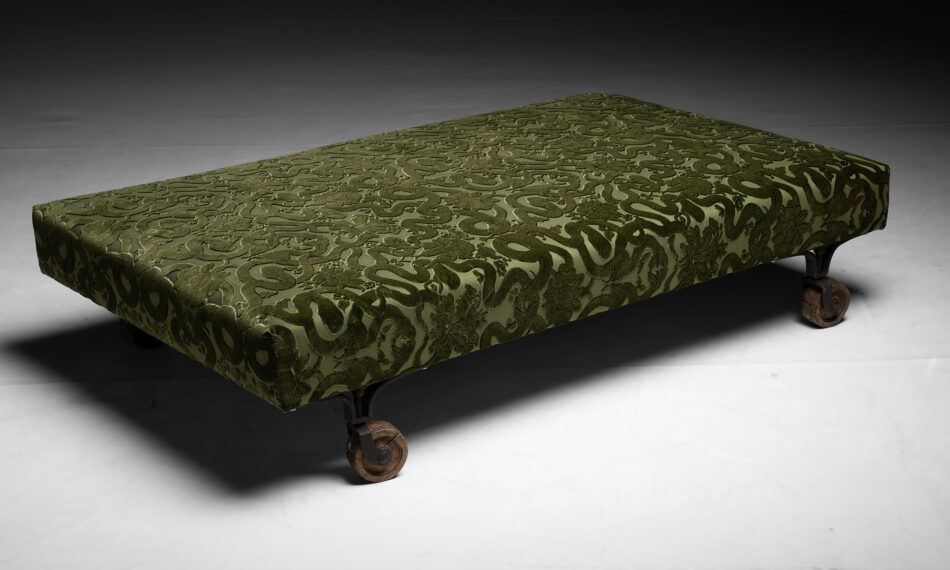
Reupholstering old furniture is a trick of the trade right out of Decorating 101 for a good reason: In the right hands, a fabric update can be utterly transformative. “It’s almost like in the movie Avatar, when they plug in,” says Ray Azoulay, owner of Obsolete, a purveyor of famously chic antique and vintage furniture and contemporary art in Culver City, California. “These pieces just come to life.”
Since Azoulay founded Obsolete, in 2001, reupholstering antique and vintage frames — chairs, sofas, daybeds, ottomans — has evolved from a practical solution to “an initiative,” he says. “I’m not the one to discover the idea of reupholstering these things. But I don’t think it’s ever been done to this level by antique dealers.”
Azoulay scours European and British sources for old furniture — from 18th-century French sofas to 1970s Vladimir Kagan pieces — which he then pairs with textiles from high-end artisanal producers like Pierre Frey and Rosemary Hallgarten. It’s not surprising to learn that he came to antiques via the fashion industry, where he developed his deep understanding of different fabrics working in menswear.
We asked Azoulay to shed light on his passion for reupholstering, his preference for rich colors and patterns and his take on current textile trends.


What sparked your passion for reupholstering antiques?
In the antique buying we do, sofas and chairs in original fabrics are always part of the mix. When I saw all of these frames and these either worn-out or no longer appropriate kinds of fabrics, I thought, Why don’t we just give them a new life, a new opportunity? Their structure is better than most contemporary things being produced, since they were made in England or France and designed to last. We’d bring the antique frames back from Europe and have them firmed up or reupholstered and recovered. And that’s when we saw the reaction from our clients.
What goes into your textile-selection process?
Someone asked me, “How do you pick these things,” and I said, “It’s all selfish. It’s just what I love.” I love looking at frames and finding the fabric that works with them. It’s kind of my return to fashion. I was a menswear designer and director of design for Liz Claiborne menswear and Macy’s corporate for years, so I have a good understanding of fabric and form. I could look at fabric — plaids, patterns, prints — and decide if it was going to be a pair of pants, a sport jacket, a shirt . . .That knowledge and understanding of textiles — the feel and hand of them, the weight of them, how they drape, the size of the pattern and what the end use was going to be — have all served this upholstery project.
Do you buy furniture and reupholster it for specific spaces or clients?
No. We don’t have an end use in mind. We allow the frame to dictate what the fabric should be rather than the other way around. So, if we have a massive French sofa with a huge back and a huge seat, we can use an incredible repeat and boldness and graphic-ness that nobody could convince a client to use based on just a swatch.

You seem to stay away from safe neutrals.
I think it would help if people thought of their upholstery as an expression that is beyond beige. I remember when I was in fashion, I went to one of the Italian mills, and the head of the mill said, “We have such an extraordinary range of colors, and the patterns are amazing — and then everyone buys black.” In this world, they buy ivories and beiges.
You have no fear of bold patterns, do you?
I think when fashion goes from solids to patterns, it really separates the people who get it from those who don’t. You’ll see all of the attempts at it, and so many are bad. I have no fear of fabric and pattern. When Alessandro Michele took over Gucci and I saw the patterns being introduced in fashion, it opened up the possibility of these classic, almost Liberty or House of Hackney types of patterns. And because I was in fashion, I could see that trend and see how it was going to move over into home furnishings.


What is the demand like for antique frames?
I was talking to a dealer in Parma, Italy, where there is a huge antiques fair — Mercanteinfiera — twice a year. He told me that an 18th-century chest of drawers would have cost 10,000 or 15,000 euros five years ago, but now they’re going for 5,000 euros, because the young people of Italy are not interested in antiques — they’re interested in the new. But I do think there is a movement of people coming back to pieces with extraordinary form from the 17th, 18th and 19th centuries.
There are so many vintage-design reissues on the market. Do you think buyers can tell the difference?
Ellen DeGeneres was buying a lot from us. There might be something like a Gras lamp, which you could buy new from DWR or wherever, but she was like, “I see the difference.” It’s good to know there are people out there who can tell something new from something that has character and soul and uniqueness.

When you’re shopping for antiques or fabric, do you know what you’re looking for, or do you wait for something to strike you?
I never know what I’m looking for.
Are you seeing any trends coming down the pipeline?
I think there’s a movement toward embroideries. There is this return to craftsmanship, almost like the return to analog, in a way. I love these embroideries by Pierre Frey. Compared with a print, they seem alive and full of personality and soul.








